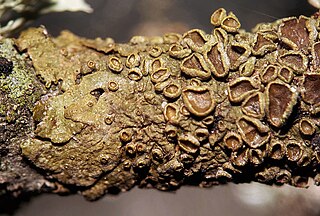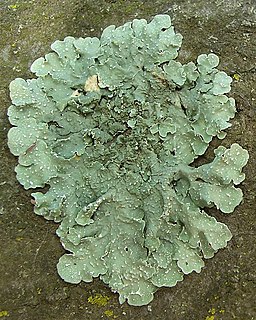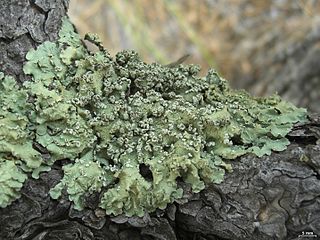
Parmelia is a genus of medium to large foliose lichens. It has a global distribution, extending from the Arctic to the Antarctic continent but concentrated in temperate regions. There are about 40 species in Parmelia. In recent decades, the once large genus Parmelia has been divided into a number of smaller genera according to thallus morphology and phylogenetic relatedness.

Flavoparmelia caperata, the common greenshield lichen, is a foliose lichen that grows on the bark of trees, and occasionally on rock.

Flavoparmelia baltimorensis, the rock greenshield lichen, is a medium to large foliose lichen with a yellow green upper thallus surface when dry; its lobes are rounded without pseudocyphellae; and the upper surface is covered with globose, pustule-like growths resembling isidia. The lower surface is black with a narrow brown zone at the margins.

Flavoparmelia is a genus of foliose lichens in the family Parmeliaceae. Because of their appearance, they are commonly known as greenshield lichens. The widely distributed genus contains 32 species. It was circumscribed by American lichenologist Mason Hale in 1986 to contain 17 former Pseudoparmelia species with broad lobes, usnic acid in the cortex, and isolichenan in the cell walls.

Punctelia is a genus of foliose lichens belonging to the large family Parmeliaceae. The genus, which contains about 50 species, was segregated from genus Parmelia in 1982. Characteristics that define Punctelia include the presence of hook-like to thread-like conidia, simple rhizines, and point-like pseudocyphellae. It is this last feature that is alluded to in the vernacular names speckled shield lichens or speckleback lichens.

Xanthoparmelia is a genus of foliose lichen in the family Parmeliaceae. Xanthoparmelia is synonymous with Almbornia, Neofuscelia, Chondropsis, Namakwa, Paraparmelia, and Xanthomaculina. This genus of lichen is commonly found in the United States, as well as Australia, New Zealand and Ecuador.
Bulbothrix meizospora is a species of foliose lichen in the family Parmeliaceae. It is found in Africa, Asia, and South America, where it grows on tree bark.

Melanohalea subolivacea, commonly known as the brown-eyed camouflage lichen, is a species of foliose lichen in the family Parmeliaceae.
Punctelia ulophylla is a species of foliose lichen in the family Parmeliaceae. It is found in Europe, where it grows on the bark of a variety of trees.
Punctelia negata is a little-known species of foliose lichen in the family Parmeliaceae. It is found in South America.

Punctelia punctilla is a species of foliose lichen in the family Parmeliaceae. It is found in Africa, South America, and North America, where it grows on bark and on rocks. The main characteristics that distinguish Punctelia punctilla from other species of Punctelia are the presence of isidia on the thallus surface, a pale brown thallus undersurface, and the presence of lecanoric acid in the medulla.

Punctelia hypoleucites, commonly known as the southwestern speckled shield lichen, is a species of foliose (leafy) lichen in the family Parmeliaceae. First formally described by Finnish botanist William Nylander as a species of Parmelia, it was transferred to the genus Punctelia in 1982. The lichen is found in Africa, North America, and South America, where it grows on the bark of both hardwood and coniferous trees. Its greenish-grey thallus is covered with tiny white pseudocyphellae – minute holes in the thallus surface that facilitate gas exchange. Some macroscopic features that help distinguish this species from other related members of the genus include the presence and the structure of the apothecia, the absence of asexual surface propagules, and the light brown color of the thallus undersurface. Chemically, the presence of lecanoric acid in the medulla and atranorin in the cortex help distinguish it from lookalikes.

Flavopunctelia flaventior is a species of foliose lichen in the family Parmeliaceae. It was first formally described as a new species by James Stirton in 1877 as Parmelia flaventior. In 1982, Hildur Krog transferred it to the subgenus Flavopunctelia of her newly circumscribed genus Punctelia, created to contain Parmelia species with punctate (point-like) pseudocyphellae. Mason Hale raised this subgenus to generic status a couple of years later, setting Flavopunctelia flaventior as the type species of the new genus. The lichen is commonly known as the speckled greenshield. Flavopunctelia flaventior occurs in Asia, Europe, East Africa, North America, and South America.
Flavopunctelia praesignis is a species of foliose lichen in the family Parmeliaceae. It was first described as Parmelia praesignis by Finnish botanist William Nylander in 1872. In 1982, Hildur Krog transferred it to the subgenus Flavopunctelia of her newly circumscribed genus Punctelia, created to contain Parmelia species with punctate (point-like) pseudocyphellae. Mason Hale raised this subgenus to generic status a couple of years later. The lichen is colloquially known as the fruiting speckled greenshield. It is found in the southern United States, in various states of Mexico, and in South America. It has also been reported from Kenya, but that may be due to misidentification.

Flavopunctelia soredica is a species of foliose lichen in the family Parmeliaceae. It was first described as Parmelia soredica by Finnish botanist William Nylander in 1872. In 1982, Hildur Krog transferred it to the subgenus Flavopunctelia of her newly circumscribed genus Punctelia, created to contain Parmelia species with punctate (point-like) pseudocyphellae. Mason Hale raised this subgenus to generic status a couple of years later. The lichen is colloquially known as the powder-edged speckled greenshield. It is widely distributed, having been recorded from North America, South America, South Africa, India, Russia, China and Japan.
Punctelia borrerina is a species of foliose lichen in the family Parmeliaceae. It is found in Mexico and South America.

Punctelia perreticulata is a widely distributed species of foliose lichen in the family Parmeliaceae. It occurs in Mediterranean Europe and Russia, North America, South America, Australia, and New Zealand, where it grows on rocks, bark, or wood. Its main distinguishing features are its thallus surface, marked with many shallow depressions, grooves, or pits, and sorediate pseudocyphellae. The lower side of the thallus is ivory to tan towards the centre and the major secondary metabolite in the medulla is lecanoric acid. A lookalike species with which it has been historically confused is Punctelia subrudecta; this lichen can be distinguished from Punctelia perreticulata by the texture of the thallus surface, or, more reliably, by the length of its conidia.

Punctelia stictica is a species of foliose lichen in the family Parmeliaceae. It is widely distributed lichen, recorded in Africa, Europe, North America, South America, and Greenland. It is typically found growing on rocks.

Punctelia borreri is a species of foliose lichen in the family Parmeliaceae. It is a common and widely distributed species, occurring in tropical, subtropical, and temperate regions of Africa, Asia, Europe, North America, Oceania, and South America. The lichen typically grows on bark of deciduous trees, and less commonly on rock. Some European countries have reported increases in the geographic range or regional frequency of the lichen in recent decades, attributed alternatively to a reduction of atmospheric sulphur dioxide levels or an increase in temperatures resulting from climate change.
Xanthoparmelia annexa is a foliose lichen species in the family Parmeliaceae. It was first formally described as a new species in 1964 by Japan lichenologist Syo Kurokawa. After being transferred to genus Paraparmelia in 1986, John Elix transferred it to the genus Xanthoparmelia in 2003 after the two genera were deemed to be synonymous.












